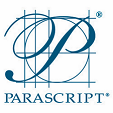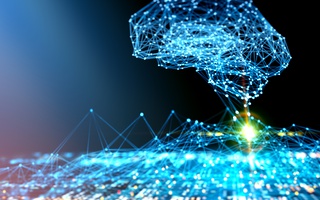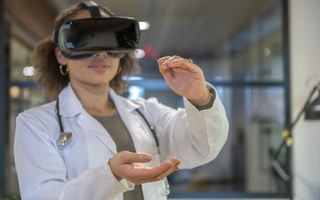Alexander Filatov, CEO and president at Parascript, a leader in the development of handwriting recognition and signature verification technologies.

In our opinion, digital transformation lies at the very heart of products created by Parascript.
With these solutions, the company's customers can save billions of dollars every year.
The arithmetic here is quite simple—as Alexander says, you just need to multiply the number of documents (envelopes, parcels, bank checks, medical and accounting forms, etc.) automatically processed by Parascript without manual data entry by the cost of manually entering a document’s data. Every year, Parascript software automatically processes dozens of billions of mail letters, bank checks, medical, insurance, and accounting forms all over the world. Manual processing of each such document usually costs a few cents. As a result, this software saves billions of dollars every year.
— Alexander, what do you consider 3 to 5 most important events in the company's history?
— The first landmark event for our company yielded no business success. We took part in the competition for the best automation solution for the US Census. They had loads of handwritten forms where many data elements could be automatically recognized—first and last name, address, eye and hair color, age, race, and so on. We didn’t simply win this competition—we crushed the competitors. Our software recognized 94% of the recognized fields with an error of less than 1%, and the company, which ranked second, trailed by more than 10%. This meant that manual data entry costs for their solution were 3 times higher than for ours. But at that time all our developers were in Moscow. I have no doubt that the U.S. Census Bureau did not dare to conclude a contract on counting the census result with a company where all developers were working in Moscow. The cold war had long since ended, but still, this was a factor to be considered. However, the result meant for us that we were the best in the world—at least in this narrow area of pattern recognition.
The second milestone in the history of our company was the automation of USPS (U.S. Postal Service). When we started this activity, 80% of the envelopes with handwritten addresses were being processed manually. More than 200 companies all over the United States had a huge number of employees entering this information. In a few years, we increased the percentage automatically recognized envelopes with handwritten addresses from 20% to 96%. Today, only one US postal data entry company remained out of these 200. To be honest, we were afraid that the employees dismissed from these 200 enterprises would find out who was to blame, but it seemed that we got away with it. Today, our address recognition software is used not only in the United States but also in Germany, England, Italy, etc. By the way, our programs also automate mail processing in Russia—in Moscow, St. Petersburg, Kazan, and other cities.
Another important domain of our business is the recognition of bank checks, both machine-printed and handwritten. At the start of our work, the best software solution was developed by Bell Labs. They could automatically recognize about 40% of checks. After we had entered the market, they had reversed the course of their business. At present, our software automatically recognizes 90% of checks with an error of less than 1%. This task is very interesting, because to prevent forgery bank checks are often printed with very intricate pictures in the background—cats, dogs and other art. We need to consider this during the binarization of images, so you have to learn to separate, so to speak, the sheep from the goats.
— What does digitalization, or digital transformation, mean to you? What is the key to successful implementation of this strategy?
— Initially, digitalization was understood mainly as the transfer of information from hard copy to digital media to reduce the costs of information processing and document archiving. Later, everyone realized that this was not the most important thing. Digital data storage enables efficient access to information and also contributes to the extraction of the insights required for the optimization and automation of management processes.
— How do you implement digitalization in your company? What is the hardest part of this process and what are its benefits?
— We are a relatively small company, so it is easy for us to achieve a high degree of digitalization. We try to avoid paper documents from the very beginning. Almost any document in our company is created, edited, distributed, and stored in digital form. We communicate with partners and customers in the same way. If any of our partners send us paper documents, we start from digitizing them.
The main benefits of this approach are the increased simplicity and effectiveness of finding the necessary information, distributing it across the company, working together on documents, and extracting and processing the original data into more abstract forms (for example, with neural networks that are an important part of our products).
— What is your vision of your market’s future? Top managers of your company are from Russia, but the company's main business is in the USA. Can you compare the situation in the IT market in the US and Russia?
— A vision of the future depends on the time scale. In a 5 to 10 year perspective, changes in the current situation will be very gradual. States and companies are rather reluctant to change. The fact that paper documents would soon become a thing of the past had been realized about 20 years ago. Life showed that this process required more than one decade, but it is definitely underway. The number of mail letters the United States has decreased, roughly speaking, by two times. The number of bank checks decreased by about three times. More and more workflows in medicine, finance, etc. are being digitized.
However, there are large market niches where paper documents still hold their ground. Automatic document processing is an emerging technology that can now be applied in domains that used to require only manual processing. One of such tasks is verifying the completeness of a document package (checking that all documents required for applying for a mortgage loan are included). Of course, the number of requests for extracting analytical information from documents has also grown considerably.
When comparing the American and Russian IT markets, we need to note that the qualification of Russian developers has always been quite high. However, the bureaucratic requirements for document workflows in Russia trail behind global standards. I have to admit that Russian companies are almost the only ones with which we exchange documents in hard copy.
Another trend worth mentioning is the prevalence of artificial intelligence technologies in the IT market. USA and other countries make very large investments in them. I know that a number of companies in Russia, such as Yandex and the Skolkovo Institute of Science and Technology, are also investing a lot in this area. I hope that other Russian companies will also start to develop AI applications. Today, Artificial Intelligence seems to be the mainstream direction for the IT market in general.
— Could you name 1 to 2 unique solutions created by your company that make you proud?
— We have many solutions we are proud of. As for me, I like our signature verification technology very much. Our algorithm can distinguish between a real signature and a fake made by professionals. This product is used to verify signatures on bank checks and on ballot papers during elections. In some countries, people can vote by mail. In this case, it is required to verify that the signature on the ballot paper matches the voter’s signature in the database. Our employees tried to compete in signature recognition with our verification algorithm but experienced an utter defeat.
I’m also fond of our document classification technology. Imagine that you receive a batch of documents without any separators in between. Your task is to separate the documents from each other and to classify them into preset types. The thing that makes this task particularly interesting is that real document streams can contain an unlimited number of documents of unknown types, in addition to several hundreds of preset types. This is a fascinating task that fuels imagination.
— Your solutions are powered by artificial intelligence technologies. How do you use AI in business and daily life?
— You know, when you work with AI technologies almost every day, you want to have a break from them at home. Jokes aside, today’s AI is most suitable for specialized tasks like document processing applications developed by our company. Another domain that successfully implements AI applications is customer support. For example, when you call the airline to solve some of your problems related to the upcoming flight, you may not be immediately connected with a real person. You will spend a few minutes talking to a speech recognition system. I have to admit that these moments for me are very unpleasant since today's AI is very poor at accent recognition. My Russian accent often completely knocks my artificial interlocutor out of service and brings me to the boiling point. That is why I prefer to minimize my interaction with AI out of office. Of course, this situation might change in the near future.
— As a leader, what do you do if you lose inspiration or face a hopeless situation?
— I was lucky in life. When, after the defense of my theses, I was choosing the company to build a career in, I successfully passed interviews in both places I applied for. The first one was a bank named Menatep (headed by that very Khodorkovsky). It offered me a salary three times higher than Paragraph (a company, from which Parascript later derived from). However, Paragraph was engaged in handwriting recognition, which always fascinated me, so the choice was clear. Since then, I have never lost inspiration at work—I really love the things I do.
Hopeless situations? I have never faced any yet. Our company recruits a special kind of people—they have strong personalities that never consider a task unsolvable. Here is the true origin story of our parent company, Paragraph. At the seminar of Academician Gelfand, Stepan Pachikov (founder of Paragraph) received a note from two young scientists who attended it. The note read: "We can solve any problem." This is how Paragraph was founded, and Parascript continues to follow this motto. Of course, there is no company that never experienced times of misfortune. Potential customers can tell us that they are already doing fine. However, the market is big, and when you can solve any problem (with a prerequisite that the task is interesting for us), then hopeless situations can never occur.
— What are the things you would never do in business? And in daily life?
— I have a personal problem—if I have given my word, I just cannot break it. Neither in business, nor in personal life can I go back on my promise.
— What has the competitive market taught you? How do you feel about the competitors’ achievements?
— Never underestimate your competitors. We respect our rivals and we know that we can never relax; otherwise, they will catch up with or even surpass us. The world is full of strong people and strong companies.
— What are you and your company working on right now? What news can be expected from your company in the near future?
— We are very actively developing deep learning technologies and improving the quality of our products based on them. Automatic continuous learning technology is one of the new products that is going to be released this year. Our products will continue automatic training after being delivered to the customer. Customers’ document flows often change over time, and our products will learn, adapt and adjust to these changes on the fly, without any human intervention. From our point of view, this task is more complicated than training a self-driving car (where all data required to teach an algorithm to drive in various conditions can be collected before launch), but this only makes the task more interesting.









